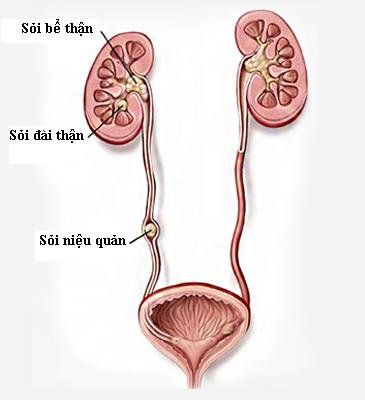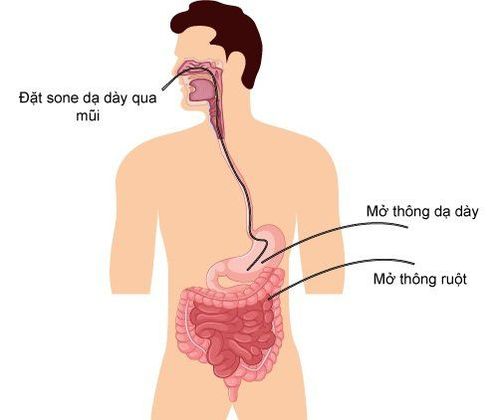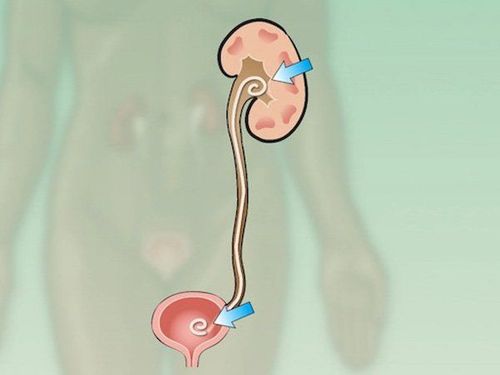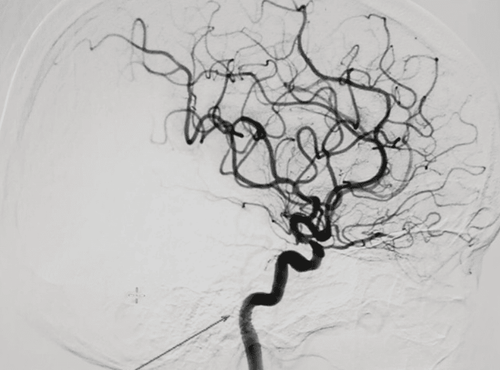This is an automatically translated article.
The article is professionally consulted by Master, Doctor Nguyen Van Phan - Head of Interventional Imaging Unit - Department of Diagnostic Imaging and Nuclear Medicine - Vinmec Times City International General Hospital. Doctor Nguyen Van Phan is an interventional radiologist and radiologist.Background digitized ureteral stenting is usually performed after failure of endoscopic retrograde ureteral stenting. Before percutaneous ureteral stenting, percutaneous pyelonephritis should be placed 2-7 days in advance.
1. What is ureteral stricture?
The ureter is the tube that carries urine from the kidney to the bladder. The length of the ureter depends on many factors such as body height, gender, kidney and bladder location. Normally, the ureter is about 25-30 cm long, about 3-5 mm in diameter. The upper half of the ureter is in the abdominal cavity, the lower half is in the pelvis.Urethral stricture is a fairly common condition in the pathology of the urinary system. There are many causes that can lead to ureteral stricture such as congenital, ureteral stones; narrowing of the ureter due to scarring. Injury to the ureter due to a penetrating wound or injury to the ureter after biopsies, obstetric procedures, after surgery in the intestines, etc. After the injury on the ureter, it will become swollen and edematous. build up and can then become blocked. Regardless of the cause of the obstruction, ureteral stenosis leads to a direct consequence of upstream hydronephrosis and to impaired renal function.
For the management of ureteral stricture, endoscopic retrograde ureteral stenting is the preferred procedure due to its ease of implementation, safety and minimal invasiveness. However, if endoscopic retrograde ureteral stenting fails, percutaneous ureteral stenting is a necessary procedure to help reestablish urinary tract output.
2-7 days before percutaneous ureteral stenting, a percutaneous pyelonephritis should be placed in the patient to resolve the increased renal pelvis pressure due to obstruction of the excretory tract and reduce the risk of excretory bleeding.

2. In what cases is percutaneous ureteral stent placement under digital background erasing angiography indicated?
To perform percutaneous ureteral stenting requires the support of imaging methods. Digital erasure angiography (DSA) makes the percutaneous ureteral stenting procedure convenient and accurate. Digitalized percutaneous ureteral stenting is indicated in many cases such as:Urethral stricture due to any cause Ureteric fistula Traumatic ureteral injury Preoperative percutaneous lithotripsy with stones larger than 15mm or single kidney poison. After retrograde ureteroscopy After ureteroplasty, digitized percutaneous ureteral stenting is contraindicated when the patient has the following diseases: bladder diverticulum, urinary incontinence, small bladder syndrome , acute urinary tract infection, urinary tract bleeding after percutaneous pyelonephritis.

3. How is percutaneous ureteral stent placement under digital background erasure angiography performed?
3.1. Prepare
The team performing the procedure includes an interventional radiologist, an interventional radiologist, and a nurse. In case the patient cannot cooperate, additional support from the doctor and anesthesiologist is needed. The necessary facilities are a digital background eraser angiogram (DSA); film, film printer, image storage system; The lead-neck dress - shirt - collar helps shield X-rays.In addition to common drugs and medical supplies such as syringes, cotton, gauze,... special medical supplies are also needed to perform stent placement. percutaneous ureters such as: chiba needles, intravascular catheter set, standard 0.035 inch lead, stiff wire, Cobra 4-5F angiography catheter, 6-12F pigtail drain (pigtail), tube ureteral catheter with two curved ends (JJ), skin sutures.
On the patient's side, the medical staff will explain the condition and purpose of the procedure so that the patient can coordinate with the doctor when performing. Patients must fast for 6 hours before the procedure. You can drink but not more than 50ml of water.
3.2. Steps to take
pyelogram - ureter downstreamThrough the percutaneous pyelonephritis catheter (made before from 2-7 days), the doctor will proceed to inject contrast material into the renal pelvis and ureter. Perform pyelonephritis downstream. Through the results of the capture, the extent and extent of the blockage will be assessed. Make an entrance to the urinary tract
The doctor will insert a 0.035-0.038 inch wire into the renal pelvis and ureter to remove the catheter. Then, insert the tube into the vascular lumen 6-8F into the renal pelvis according to the lead. Approaching the lesion
Approaching the lesion using a catheter and wire that goes from the renal pelvis, through the ureter to the bladder. Replace standard wire with stiff wire. Then remove the catheter.
Placement of ureteral stent (Double J)
According to rigid wire, ureteral stent is inserted into renal pelvis, ureter and bladder. The lead is then withdrawn back to the renal pelvis. Place a catheter to drain the renal pelvis through the skin. Contrast drug is injected into the renal pelvis, through digital angiography to clear the background, it helps to check the position of the upper end of the ureteral stent and the stent's circulation. Place a percutaneous pyelonephritis
Fix and lock the percutaneous pyelonephritis catheter. After 24-48 hours, if the ureteral stent is checked and is not obstructed, remove the percutaneous pyelonephritis catheter. Under the background digitized angiogram, ureteral stenting was successful when, in terms of position, the ureteral stent had the lower end bent in the bladder, the upper end bent in the renal pelvis. Functionally, when contrast is injected from the renal pelvis, it is seen to circulate to the bladder, not to drain the contrast out of the way of exit into the abdomen or into the retroperitoneal space.

4. Handling possible complications when percutaneous ureteral stenting under digital background erasing angiography
Infection is a possible complication of percutaneous ureteral stenting, infection has many degrees, can be local infection, urinary infection or sepsis. For infections at the drainage site, treat by cleaning and disinfecting the site, changing the dressing daily. For urinary tract infections, treat with oral or injectable systemic antibiotics. Sepsis is a serious, life-threatening infection, the hospital will conduct a specialist consultation to find an appropriate treatment plan.Another common complication is pyelonephritis and ureteral bleeding. Assess for bleeding through the amount of urine excreted through the drain and at the drain. Treatment is by manual pressing at the lumbar hole with a drain for 15-20 minutes. If bleeding continues, the patient is transferred to the intervention room to be replaced with a larger size drain. If after replacing the drain tube, the blood still flows, then vascular intervention is performed.
Percutaneous ureteral stenting is a technique that requires a high level of experience of the doctor and the perfect coordination of the patient. In addition, in order to achieve high diagnostic efficiency, patients need to choose reputable addresses with digital scanners to erase the background, modern and standard medical equipment.
Vinmec International General Hospital is a hospital with a full convergence of general and specialized doctors to perform, examine, operate, diagnose and treat kidney and urinary diseases. In particular, at Vinmec, percutaneous stenting is also performed to treat many different diseases and bring optimal treatment results to customers.
Please dial HOTLINE for more information or register for an appointment HERE. Download MyVinmec app to make appointments faster and to manage your bookings easily.














